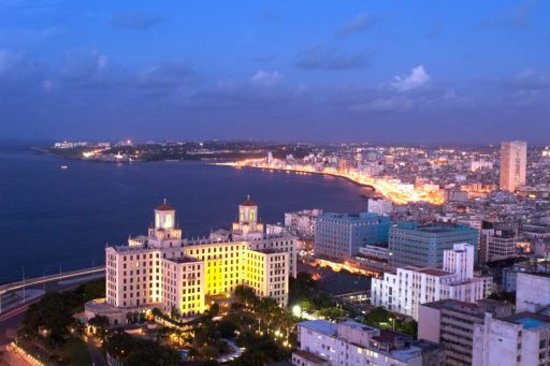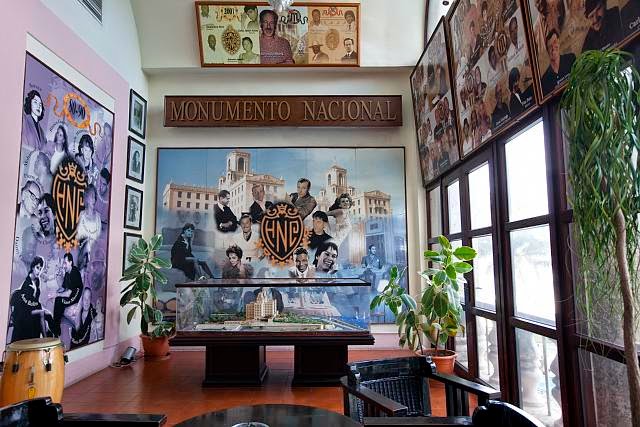 THE CUBAN “HOTEL NACIONAL” MEETS 88 YEARS OF HISTORY.
THE CUBAN “HOTEL NACIONAL” MEETS 88 YEARS OF HISTORY.
The National Hotel of Cuba, celebrates 88 years of its opening even today with the shine and elegance that challenges its many years of inauguration.
The hotel opened as The National Hotel of Cuba on December 30, 1930, operated by the American managers of the Plaza Hotel, Savoy-Plaza Hotel and Copley Plaza Hotel, at a time Cuba was a prime travel destination for people in the U.S.
In recognition of its history, elegance, and treasured documents, the National Hotel, received at the time the condition of the United Nations Organization for Education, Science and Culture (Unesco) of National Memory.
The historical relevance and the documentation that the Hotel hoards imply at the present time the recognition, one of the many attractions of that establishment that on December 30, 2018 turns 88, where the names of many celebrities are inscribed.
The directors of the installation say that the aforementioned initiative of the United Nations Educational, Scientific and Cultural Organization (Unesco) dates from 1992.
This element has three aspects: World Memory, Regional Memory and National Memory, in which this hotel is recorded.
The National Hotel of Cuba is well known, including the highlight of its Executive Floor, celebrated by many businessmen from all over the world who stay in that space.
Listed as a National Monument of Cuba, the hotel has a wonderful view of much of the capital and its sixth floor has the privileges of a very selective tourism.
Symbol of Cuban hostels, five stars, the National is operated by the hotel group Gran Caribe, accommodation where poetry marks milestones, stories from its inception.
The house had the plans of Mckim Mead and White Architectects of New York and its construction was carried out by Purdy Henderson Company that guaranteed the opening on the aforementioned date.
His lineage is confirmed by his guests, such as Johnny Weissmuller, Ava Gardner, Buster Keaton, Errol Flynn, Frank Sinatra and other stars.
In the 40s of last century the touch of distinction was provided by the Cabaret Parisien, which is currently the second best in the country after Tropicana.
With its 457 rooms, most of them facing the sea (of them 16 suites and one presidential), the hotel is also the axis of the most important meetings in the country, tourism or other areas.
But much of what is worth and shining in the world in all social spheres, they stayed in their rooms, or they passed at some point through their halls and praised the beauty of this emblematic hotel.
The National has a Hall of Fame in which you can see images of those who were in its corridors, rooms and restaurants or bars.
They indicate documents of the establishment that since its inauguration, welcomed innumerable illustrious guests with Sir. Winston Churchill, the Dukes of Windsor, Alejandro Fleming, Rómulo Gallegos, Carol II of Romania, The Kings of Belgium or Errol Flynn, long list.
Following the Cuban Revolution in January 1959, Havana’s casinos were briefly shut down, but were quickly reopened after protests by casino workers left out of work. Fidel Castro nationalized the hotel on March 20, 1960 and finally closed the casino in October 1960, almost two years after his overthrow of Batista.
There is a museum in the hotel’s gardens dedicated to its role in the 1962 Cuban Missile Crisis, when anti-aircraft guns were set up on the site of the Santa Clara Battery and an extensive series of tunnels were built under the property, which are now open to the public on guided tours.
After years of neglect due to the reduction in tourism following the revolution, the hotel was mainly used to accommodate visiting diplomats and foreign government officials. The collapse of the USSR in 1991 forced the Cuban communist party, anxious for foreign exchange reserves, to reopen Cuba to tourists.
A History of Cuba made Tourist Emblem.
 EL “HOTEL NACIONAL” CUBANO CUMPLE 88 AÑOS DE HISTORIA.
EL “HOTEL NACIONAL” CUBANO CUMPLE 88 AÑOS DE HISTORIA.
El Hotel Nacional de Cuba, celebra sus 88 años de apertura, incluso hoy, con el brillo y la elegancia que desafían sus muchos años de inauguración.
El hotel abrió sus puertas como el Hotel Nacional de Cuba el 30 de diciembre de 1930, operado por los gerentes estadounidenses del Hotel Plaza, el Hotel Savoy-Plaza y el Hotel Copley Plaza, en un momento en que Cuba era un destino de viaje principal para las personas en los EE. UU.
En reconocimiento a su historia, elegancia y documentos preciados, el Hotel Nacional recibió en su momento la condición de Organización de las Naciones Unidas para la Educación, la Ciencia y la Cultura (Unesco) de la Memoria Nacional.
La relevancia histórica y la documentación que el Hotel Hoards implica en la actualidad el reconocimiento, uno de los muchos atractivos de ese establecimiento que el 30 de diciembre de 2018 cumple 88 años, donde están inscritos los nombres de muchas celebridades.
Los directores de la instalación dicen que la iniciativa mencionada de la Organización de las Naciones Unidas para la Educación, la Ciencia y la Cultura (Unesco) data de 1992.
Este elemento tiene tres aspectos: memoria mundial, memoria regional y memoria nacional, en la que se registra este hotel.
El Hotel Nacional de Cuba es bien conocido, incluido el punto culminante de su Piso Ejecutivo, celebrado por muchos hombres de negocios de todo el mundo que se alojan en ese espacio.
Catalogado como Monumento Nacional de Cuba, el hotel tiene una vista maravillosa de gran parte de la capital y su sexto piso tiene los privilegios de un turismo muy selectivo.
Símbolo de los albergues cubanos, cinco estrellas, el nacional es operado por el grupo hotelero Gran Caribe, alojamiento donde la poesía marca hitos, historias desde sus inicios.
La casa tenía los planes de Mckim Mead y White Architectects de Nueva York y su construcción fue llevada a cabo por Purdy Henderson Company que garantizó la apertura en la fecha mencionada.
Su linaje es confirmado por sus invitados, como Johnny Weissmuller, Ava Gardner, Buster Keaton, Errol Flynn, Frank Sinatra y otras estrellas.
En los años 40 del siglo pasado, el toque de distinción fue proporcionado por el Cabaret Parisien, que actualmente es el segundo mejor en el país después de Tropicana.
Con sus 457 habitaciones, la mayoría de ellas frente al mar (de ellas 16 suites y una presidencial), el hotel es también el eje de las reuniones más importantes del país, el turismo u otras áreas.
Pero gran parte de lo que vale y está brillando en el mundo en todas las esferas sociales, se quedaron en sus habitaciones o pasaron por algún lugar por sus pasillos y elogiaron la belleza de este hotel emblemático.
The National tiene un Salón de la Fama en el que puedes ver imágenes de los que estaban en sus pasillos, habitaciones y restaurantes o bares.
Indican documentos del establecimiento que, desde su inauguración, recibieron a innumerables huéspedes ilustres con Sir. Winston Churchill, los duques de Windsor, Alejandro Fleming, Rómulo Gallegos, Carol II de Rumania, Los reyes de Bélgica o Errol Flynn, larga lista.
Después de la Revolución cubana en enero de 1959, los casinos de La Habana se cerraron brevemente, pero se reabrieron rápidamente después de las protestas de los trabajadores del casino que se quedaron sin trabajo. Fidel Castro nacionalizó el hotel el 20 de marzo de 1960 y finalmente cerró el casino en octubre de 1960, casi dos años después de su derrocamiento de Batista.
Hay un museo en los jardines del hotel dedicado a su papel en la Crisis de los Misiles Cubanos de 1962, cuando se instalaron cañones antiaéreos en el sitio de la Batería de Santa Clara y se construyeron una extensa serie de túneles bajo la propiedad, que ahora están Abierto al público en visitas guiadas.
Después de años de abandono debido a la reducción del turismo después de la revolución, el hotel se utilizó principalmente para acomodar a diplomáticos visitantes y funcionarios gubernamentales extranjeros. El colapso de la URSS en 1991 obligó al partido comunista cubano, ansioso por las reservas de divisas, a reabrir Cuba a los turistas.
Una historia de Cuba hecha emblema turístico.
Agencies/ PL/ Various/ Roberto F. Campos/ Internet Photos/ Arnoldo Varona/ www.TheCubanHistory.com
THE CUBAN HISTORY, HOLLYWOOD.







